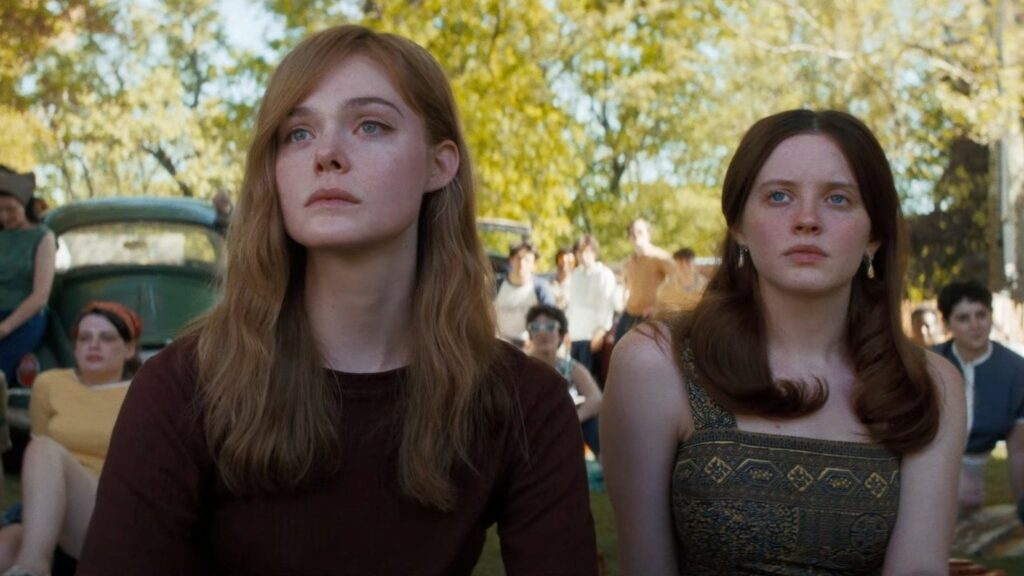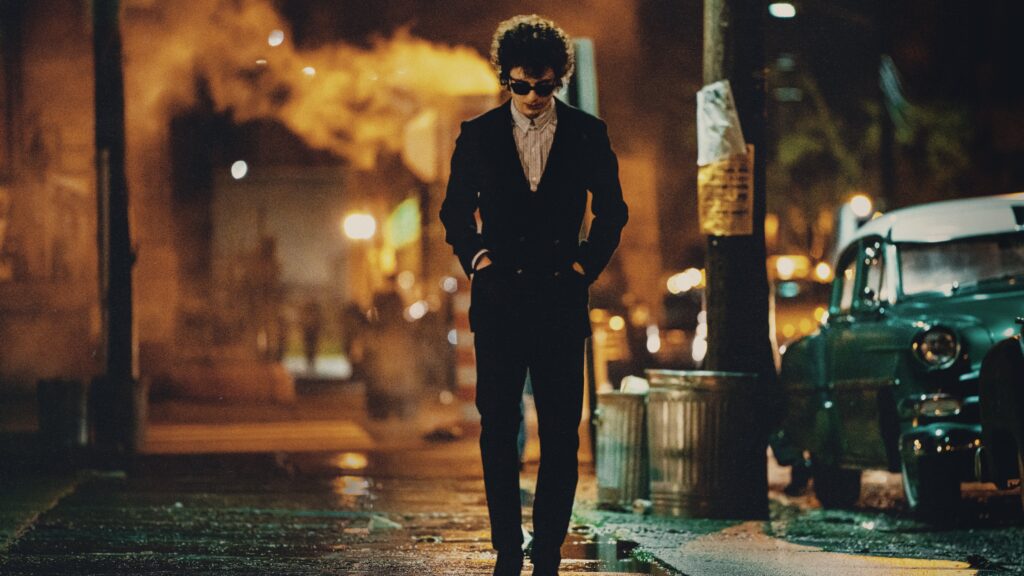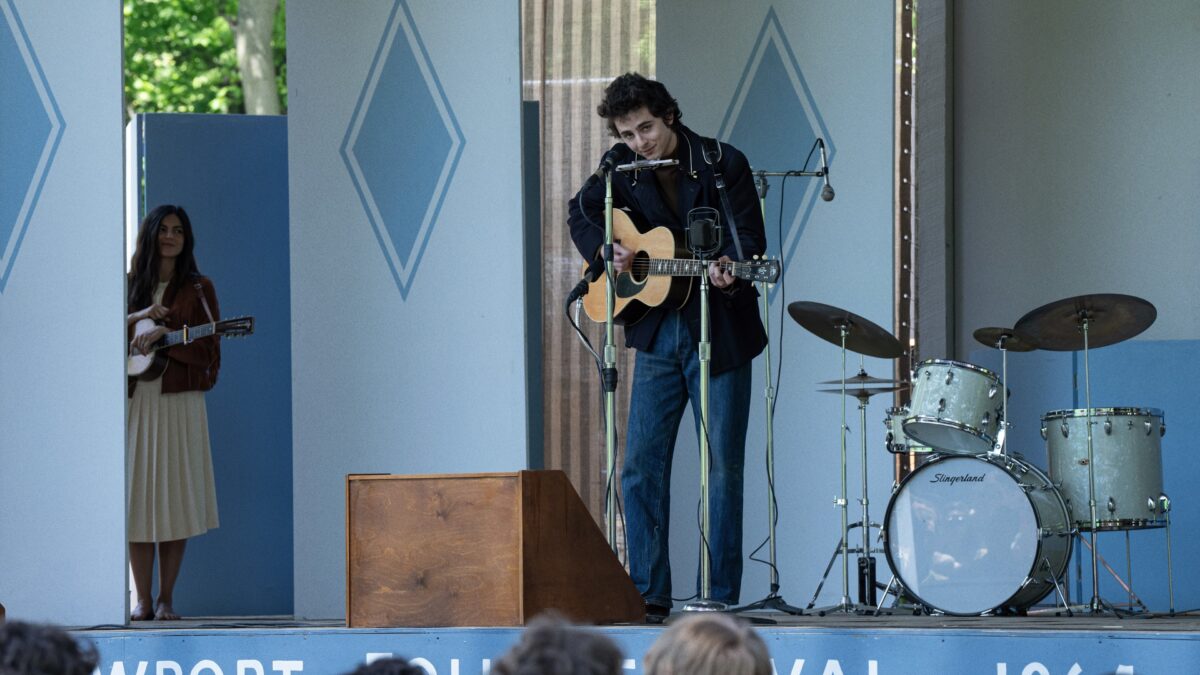Threw the bums a dime in your prime, didn't you?
There’s a scene at the center of A Complete Unknown good enough to justify the film’s entire existence. Bob Dylan (Timothée Chalamet), a few months off the release of The Freewheelin’ Bob Dylan — one of a half dozen seminal albums he’d drop in the ’60s and ’70s — takes the stage at the Newport Folk Festival in 1964. He begins playing “The Times They Are A-Changin’” to a crowd belting along and cheering like it’s “She Loves You” on Ed Sullivan. When the final chord lands, Dylan stands still, surveying the crowd with an enigmatic look. (Everything Bob does in this movie is either authentically or performatively enigmatic.)
Watching from various vantage points are the key players in Bob’s Greenwich Village orbit. In the audience is Sylvie Russo (Elle Fanning), Dylan’s sometimes-girlfriend and walking embodiment of wide-eyed bohemia. Tears well in her eyes from the dawning recognition of a growing but inscrutable distance from Dylan. Joan Baez (Monica Barbaro) watches from the wings, her face a mix of admiration and unease. And Pete Seeger (Edward Norton), the saintly steward of folk music, basks in a moment he does not recognize as the precipice from which he can only fall: his vision of folk has become the anthem of the people under his tutelage — for a short time, anyway.
Director James Mangold and editors Andrew Buckland and Scott Morris stage the scene like a carousel. The camera floats in slow circles around Dylan onstage with reverse shots of his observers, one at a time, all offering outstanding reaction shots: Sylvie, Joan, Pete, and some other interlopers like Johnny Cash (Boyd Holbrook) — each reflecting a small fragment of the mid-60s music scene. They are all in Bob Dylan’s orbit. It’s not the movie’s flashiest scene, but it’s a masterpiece in its own way, understated and pregnant with potential energy. The times, the nation, the art, and the artist are all, indeed, a-changin’.
This scene hits exactly halfway through the movie, which is the trouble. A Complete Unknown runs at just about The Devil’s Runtime (i.e. 145 minutes), and its second half is a comedown from the first, which is quite excellent. My second time watching, in particular, I admired how tightly built and thoughtfully layered the opening hour is. Every beat in the film’s first half serves rich thematic ripples cresting with “A-Changin’”: How does music galvanize people? What is the line between folk and pop, between protest music and radio music, and who decides where it lies? How do cultural figureheads like Seeger and Cash and the dying Woody Guthrie (Scoot McNairy) both shape the change they usher in and react to it when it slips from their fingers? What sway do each of the people in Dylan’s life have over his mind and heart? What do the answers to these questions say about a nation undergoing a metamorphosis? A Complete Unknown teases these threads out and thrives on their tension.

Unfortunately, the second half mostly untangles them by shouting. All the ideas elegantly compressed into the 1964 Newport Folk Festival scene are unspooled and smacked with a hammer. The back stretch leans into the usual biopic narrative: the fame builds, the ego inflates, the relationships crack. Thankfully, it sidesteps the worst of it — no major drug spirals, no sink smashing — but there are moments where it teeters into melodrama.
Mangold’s direction is sturdy until it isn’t. He toggles on a scene-by-scene basis between clearly knowing what story he wants to tell and just schlepping out the greatest hits and the famous figures. Of course, a lot of the biopic playbook clichés this film brushes up against are ones Mangold himself helped codify with Walk the Line, a film I remain quite ambivalent about. He’s good when observing the inherent friction between Dylan the mystery man and Dylan the counterculture icon. But when sands it down into conventional narrative and boxes it into the familiar beats, even the iconic ones (like the subsequent, more famous performance at Newport when he went electric), he makes the mythology smaller, not sharper.
The movie is quite handsome, and it does so without being too try-hard (*glares at Maestro*). Cinematographer Phedon Papamichael nails a vibrant, tactile ‘60s look without slathering on the usual sepia-tinged nostalgia. Nighttime scenes in Greenwich Village have this bracing chill to them — you can almost smell the tobacco-steeped bars and feel steam from the sewer grates as he wanders around Manhattan, brooding. It captures the romance of the time without putting it on a pedestal.

The cast across the board is dialed in. Chalamet knows the film rests on his shoulders, and he mostly pulls it off. Certainly, the gestures and the voice are sufficiently transformed, so you’re not constantly noticing them. On second viewing, I liked his work even more. I noticed a lot of deliberate micro-flickers of emotions and thoughts, little darts that keep the portrayal from feeling too museum-glass or inorganic. Fanning as Sylvie is a standout, grounding the film in a tangible emotional arc even as her character gets shuffled to the edges in the second half. Barbaro is convincing as Baez (and she sings quite well), but the character is a tricky mix of femme fatale and artistic muse that never quite clicks, and Barbaro seems a little baffled how to make her pop. Norton, meanwhile, finds just the right pitch for Seeger: gentle, generous, but always patronizing and a few inches out of reach emotionally. McNairy is wonderful and gutting in a nearly wordless part as the dying Guthrie.
By the end, A Complete Unknown lands as one of the more tolerable entries in a genre I usually find insufferable. It has a great ensemble, a few knockout sequences, and the good sense to build the entire affair around Dylan’s elusiveness — I mean, that’s the point of the title. (Speaking of which, what do you think will be the last quote from “Like a Rolling Stone” to be used as the title for a Dylan retrospective? “Chrome Horse and Your Diplomat?” Then, at last, a new song can be good. Shout out to friend of The Goods and sleep scientist Olivia for giving me written permission to steal this joke from her, which she made about Hamlet’s Act 3 Scene 1 soliloquy on her webcomic many years ago.)
I very much wish the story were tighter — did we really need nearly two and a half hours to learn that Dylan was mercurial? But it’s got something real in there during its best moments, especially in its first half. If nothing else, it immerses you in the idea that, if you surround yourself with the right people at the right time, you really will see the times a-changin’.
Is It Good?
Good (5/8)
Awards, Honors, & Rankings
- The B.A.D.S. (2024) - Best Ensemble (Nominee)
- The B.A.D.S. (2024) - Best Supporting Actress (Elle Fanning) (Nominee)
Dan is the founder and head critic of The Goods. Follow Dan on Letterboxd. Join the Discord for updates and discussion.

